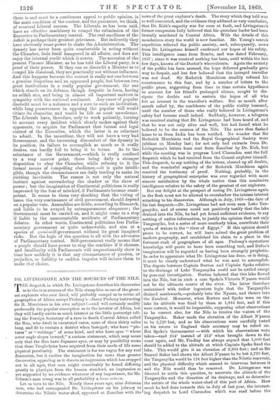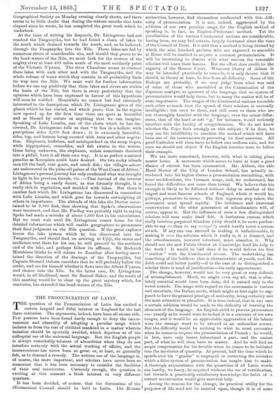DR. LIVINGSTONE AND THE SOURCES OF THE NILE.
TUE despatch in which Dr. Livingstone describes his discoveries as to the true sources of the Nile stamp him as one of the great- est explorers who ever lived, will probably compel us to revise all geographies of Africa except Ptolemy's—fancy Ptolemy instructing Sir R. Murchison in his own subject 1—and will certainly modify profoundly the popular conception as to the interior of Africa, but they will hardly excite as much interest as the little postscript tell- ing the Foreign Secretary of a race in South Central Africa called the Rua, who dwell in excavated caves, some of them thirty miles long, and fit to contain a district when besieged ; who have "pic- tures" or " writings " of some kind, and who have eyes "whose outer angle slopes inward," a curious statement, which may mean only that the Rua have Japanese eyes, or may by possibility mean that these Troglodytes have acquired from their mode of life some physical peculiarity. The statement is far too vague for any real discussion, but it excites the imagination far more than greater discoveries, appealing as it does to an impression which has cropped out in all ages, that men might conceivably be found differing greatly in physique from the human standard, an impression as yet supported by no evidence whatever of any importance, for Mr. Gibson's man urang was in all probability a haus naturx.
Let us turn to the Nile. Nearly three years ago, nine Johanna men, who had accompanied Dr. Livingstone on his johrney to determine the Nilotic water-shed, appeared at Zanzibar with the news of the great explorer's death. The story which they told was so well concocted, and the evidence they adduced so very conclusive, that Dr. Kirk's sagacity was for once at fault, and Livingstone's former companion fully believed that his quondam leader had been brutally murdered in Central Africa. With the details of this mendacious story the world is now familiar. Mr. Young's search expedition relieved the public anxiety, and, subsequently, news from Dr. Livingstone himself confirmed our hopes of his safety. This intelligence came from Bemba, and was dated February, 1867; since it was received nothing has been, until within the last few days, known of the Doctor's whereabouts. Again the anxiety of the public has been aroused, the hope deferred gradually gave way to despair, and but few believed that the intrepid traveller was not dead. Sir Roderick Murchison steadily refused his countenance to this fear, and by a number of letters to the public press, suggesting from time to time certain hypotheses to account for his friend's prolonged silence, sought to dis- sipate the doubts and to sustain the hopes of all who felt an interest in the traveller's welfare. But as month after month rolled by, the confidence of the public visibly lessened, until the number of those who really believed in Livingstone's safety had become small indeed. Suddenly, however, a telegram was received stating that Dr. Livingstone had been heard of, and that he was not only alive and well, but had found what he believed to be the sources of the Nile. The news thus flashed home to us from India has been verified. No wonder that Sir Roderick Murchison and the Royal Geographical Society were jubilant on Monday last ; for not only had extracts from Dr. Livingstone's letters been sent from Zanzibar by Dr. Kirk, but while the meeting was in progress Lord Clarendon sent the full despatch which he had received from the Consul-explorer himself. This despatch, to say nothing of the letters, cleared up all doubts, and the wonderful sagacity of Sir Roderick Murchison again received the testimony of proof. Nothing, probably, in the history of geographical enterprise was ever regarded with more sincere satisfaction by the whole nation than this conclusive intelligence relative to the safety of the greatest of our explorers.
But our delight at the prospect of seeing Dr. Livingstone again in the flesh must not be allowed to overshadow the intense interest attaching to his discoveries. Although in July, 1868—the date of his last despatch—Dr. Livingstone had not even seen Lake Tan- ganyika, and of course could not positively testify that the lake drained into the Nile, he had yet found sufficient evidence, to say nothing of native information, to justify the opinion that not only Tanganyika, but a series of more southerly lakes, contribute their quota of waters to the "river of Egypt." If this opinion should prove to be correct, he will have solved the great problem of modern geography, and established his claim to a place in the foremost rank of geographers of all ages. Ptolemy's mysterious knowledge will prove to have been something real, and Defoe's imagination will be regarded as having been strangely prophetic. In order to appreciate what Dr. Livingstone has done, or is doing, it must be clearly understood what he was sent to accomplish. The dispute between Captain Burton and Captain Speke relative to the drainage of Lake Tanganyika could not be settled except by personal investigation. Burton believed that this lake flowed into the Nile, but in such a case Speke's Victoria N'yanza would not be the ultimate source of the river. The latter therefore maintained with rather ingenious logic that the Tanganyika drained southwards,—probab]y into the Nyassa, and thence into the Zambezi. Moreover, when Burton and Spoke were on the lake its altitude was fixed by them at 1,844 feet, and if this were correct, it would be impossible, supposing other observations to be correct also, for the Nile to receive the waters of the Tanganyika. Baker made the elevation of the Albert N 'yanza to be 2,720 feet, and as his observations were carefully tested on his return to England their accuracy may be relied on. But Speke's thermometer — with which his observations were taken—read 214° instead of 212° when brought down to the coast again, and Mr. Findlay has always argued that 1,000 feet should be added to the altitude at which Captain Spoke fixed the lake. This would give it an elevation of 2,844 feet ; and as Sir Samuel Baker had shown the Albert N'yanza to be but 2,720 feet, the Tanganyika would be 124 feet higher than the Nilotic reservoir, and the physical difficulty which seemed to intervene between it and the Nile would thus be removed. Dr. Livingstone was directed to settle this question, to ascertain the altitude of the Tanganyika and the direction of its drainage, and to determine the nature of the whole water-shed of this part of Africa. How much he had done towards this in July of last year, the interest- ing despatch to Lord Clarendon which was read before the Geographical Society on Monday evening clearly shows, and there seems to be little doubt that during the sixteen months that have elapsed since he wrote, he has completed the great work which he undertook.
At the time of writing his despatch, Dr. Livingstone had not reached the Tanganyika, but he had found a chain of lakes to the south which drained towards the north, and, as he believed, through the Tanganyika into the Nile. These lakes are fed by numerous rivers of considerable size, and should they prove to be the head-waters of the Nile, we must look for the sources of the mighty river at least 400 miles south of the most southerly point of the Victoria N'yanza. The river Chambese seems to connect these lakes with each other and with the Tanganyika, and the whole volume of water which they contain in all probability finds its way into the Nile. We must wait for further information before we can say positively that these lakes and rivers are within the basin of the Nile, but there is every probability that the opinions which have been expressed in favour of this hypothesis will soon be verified. Meanwhile we cannot but feel extremely interested in the descriptions which Dr. Livingstone gives of the places which he has visited, and which prove that in the region now opened up for the first time there are spots as beautiful and as blessed by nature as anything that we can imagine. Speaking of Lake Liemba, one of the chain which he has dis- covered, Dr. Livingstone tells us that "it lies in a hollow, with precipitous sides 2,000 feet down ; it is extremely beautiful, sides, top, and bottom being covered with trees and other vegeta- tion. Elephants, buffaloes, and antelopes feed on the steep slopes, while hippopotami, crocodiles, and fish swarm in the waters. Guns being unknown, the elephants, unless sometimes deceived into a pitfall, have it all their own way. It is as perfect a natural paradise as Xenophon could have desired. On two rocky islands men till the land, rear goats, and catch fish ; the villages ashore are embowered in the palm-oil palms of the West Coast of Africa." Livingstone's present journey has only confirmed what was brought to light in his previous travels, viz. :—That instead of the interior of Africa being a sandy desert, as was formerly thought, it is really rich in vegetation, and studded with lakes. But there is another fact which Dr. Livingstone has discovered in connection with Lake Liemba, and which goes far towards outweighing all others in importance. The altitude of this lake the Doctor ascer- tained to be 2,840 feet, thus showing that Speke's observations were incorrect, and that Mr. Findlay was probably right in saying Speke had made a mistake of about 1,000 feet in his calculations. But we must wait until Dr. Livingstone conies home for the detailed information which will enable geographers to pronounce their final judgment on the Nile question. If the great explorer traces the lake system which he has discovered into the Tanganyika, and should find, on arriving at Ujiji, the stores and medicines sent there for his use, he will proceed to the northern end of the lake, and perhaps follow its affluent. Sir Roderick Murchison thinks he will return to Zanzibar after having ascer- tained the direction of the drainage of the Tanganyika, but Captain Sherard Osborn considers that he will probably follow the outlet, and see for himself whether it flows into the Albert N'yanza, and thence into the Nile. In the latter case, Dr. Livingstone would, in all likelihood, meet Sir Samuel Baker, and the result of this meeting would be to clear up the great mystery which, for centuries, has shrouded the head-waters of the Nile.



































 Previous page
Previous page